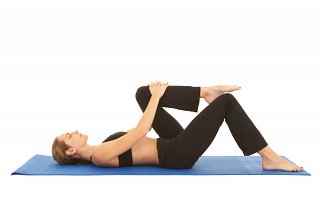Sciatica Home Treatment
Home Treatment for Sciatica
Discover the cause of your pain first.
Home exercises to treat Sciatica can offer very effective relief - but exercises should only be performed following a full diagnosis by your Physiotherapist, who will advice on what are the correct exercises for you.

Following treatment, I almost always recommend a home treatment program for Sciatica, and have included some basic home exercises that can help treat sciatica below. Before we look at some approaches to a home treatment exercise program, it is useful to understand the source and typical presentation of your sciatica.
Put simply - sciatica is a term used to describe nerve pain in your leg arising from your sciatic nerve. Your sciatic nerve comes from the base of your back and travels down your leg as far as your toes. When impinged, you may experience a range of sciatica symptoms ranging from back and upper leg pain to a raging pain down the back of your leg. Pins and needles as well as numbness can also be associated with your sciatic nerve.
The severity and extent of your sciatic pain will dictate the type of home treatment exercises you will perform at home. That is why you should consult a physiotherapist to get clear diagnosis of the cause of your sciatic pain.
For example if the cause of your sciatica is due to a herniated disc, the treatment path you undertake will be different to sciatica pain caused by a tight piriformis muscle.
It is possible to increase your pain if you undertake the wrong treatment following an incorrect diagnosis, so if in doubt, seek an expert’s diagnosis and be clear on what you should do to treat sciatica at home. Read more about this in Home exercises for Sciatica
Sponsored links
Treatment for Sciatica
Treatment for sciatica will involve manual techniques to unload the compressed or trapped nerve, and may also require pain relief and anti-inflammatory medications. Following your initial diagnosis, you will also have some exercise programs which you should complete. Here are some effective home treatments for sciatica:
- Apply heat frequently to your lower back. I advise that you lie on your back with your knees bent up (put two pillows underneath your knees if it helps) and apply a hot water bottle wrapped in a towel for 20 minutes every 2 hours. This will help relax tight muscles and ease any compression on the sciatic nerve.
- Lie on your side with your knees bent and a pillow between your knees. Preferably with the painful side up.
- Lie on your back with 2 pillows under your knees so that they are not straight. This reduces the pressure on the sciatic nerve.
- Take regular anti-inflammatory medication if the pain is severe.
- Avoid sitting for prolonged periods.
- Move all parts of your body that do not hurt. This will help in your recovery - and remind you that the rest of your body is ok!
- Balance movement and rest. I often hear clients saying that they have stayed in bed for days with sciatica. Do not do this. Rest for 20 minutes in every hour where possible, and move around in an easy, pain free way after that.
- Avoid any lifting - or at the very least use a correct lifting technique.
- Listen to your pain, and do as it is asking from the outset (this may involve movement, rest, medication - or stopping a particular activity that is aggravating your sciatica). This will help you on the road to recovery. Your body is clever and will tell you what you need to do!
- Listen to the specific advice given to you by your physiotherapist, as each sciatica case is unique and will require specific treatments at home as well as at the physiotherapy clinic.
I hope that these tips will help! Just remember, if you find these exercises painful, then go and seek the advice of a Chartered Physiotherapist or your Doctor. Good luck!
Read More-
Discover some of the common Stretches for Sciatica here
DISCLAIMER
While the content and materials contained in the articles on this website have been written & researched by Sally Ann Quirke, a professional, practising & fully qualified Chartered Physiotherapist (Physical Therapist) based in Ireland, they are provided for general information and educational purposes only. They do not constitute medical advice on any particular individual situation. Please see your Chartered Physiotherapist or other medical practitioner for full and individual consultation.
Please read the full disclaimer here.
Cookies and Privacy
By using this website, you consent to the use of cookies in accordance with our cookie policy. For more information on how we use cookies, please read our cookie policy here.
